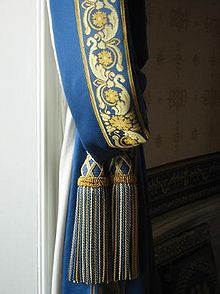Tassel


A tassel is a finishing feature in fabric decoration. The tassel is a universal ornament that is seen in varying versions in many cultures around the globe.
Etymology
The word "tassel" comes from the Latin "tassau" which meant a clasp (as for the neck of a garment).
History and use
In the Western World tassels were originally a series of windings of thread or string around a suspending string until the desired curvature was attained. Decades later, turned wooden moulds, which were either covered in simple wrappings or much more elaborate coverings called "satinings", were used. This involved an intricate binding of bands of filament silk vertically around the mould by means of an internal "lacing" in the bore of the mould.
These constructions were varied and augmented with extensive ornamentations that were each assigned an idiosyncratic term by their French practitioners. In France those practitioners were called "Passementiers", and an apprenticeship of seven years was required to become a master in one of the subdivisions of the guild. The French widely exported their very artistic work, and at such low prices that no other nation developed a mature "trimmings" industry. Tassels and their associated forms changed style throughout the years, from the small and casual of Renaissance designs, through the medium sizes and more staid designs of the Empire period, and to the Victorian Era with the largest and most elaborate. Some of these designs are returning today from the European and American artisans who may charge a thousand dollars for a single hand-made tassel.
Tassels (also called tufts) were traditionally worn by Oxford and Cambridge University undergraduates on their caps (hence a slang word - tassel for an undergraduate), those wearing gold tassels were titled sons of the peers who had a right of vote in the House of Lords.
Ceremonial wear
Tassels, or liripipes, are also found on mortarboards during university graduation ceremonies and possibly upon the shoes of the graduates at the ceremony. Near the conclusion of the graduation ceremony the tassel that hangs from the graduate's mortarboard is moved from the right to the left. Typically the entire graduating class does this in unison. [citation needed]
Creation
A tassel is made by binding plaited or otherwise gathered threads from which at one end protrudes a cord on which the tassel is hung, and which may have loose, dangling threads at the other end. Tassels are normally decorative elements, and as such one often finds them attached, usually along the bottom hem, to garments, curtains, breasts (nipples) of Burlesque dancers, or other hangings.
A tassel is primarily an ornament, and was at first the casual termination of a cord to prevent unraveling with a knot. As time went on, various peoples developed variations on this, until by the time of sixteenth century in France the first Guild of Passementiers was created and documented the art of passementerie. The tassel was its primary expression, but it also included fringes (applied, as opposed to integral), ornamental cords, galloons, pompons, rosettes, and gimps as other forms. Tassels, pompons, and rosettes are point ornaments; the others are linear ornaments. The parts of a tassel are basically, from top to bottom:

- Suspending cord;
- Its body, which is usually made up of one or more moulds;
- A skirt of fringe or other ornaments.
See also
References
- Guide to Passementerie. Scalamandre Silks. New York.
- Boudet, Pierre and Bernard Gomon, La Passementerie, Dessain et Tolra, 1981. ISBN 978-2249251085.
- Pegler, Martin, The Dictionary of Interior Design, Fairchild Publications, 1983. ASIN B0006ECV48.
